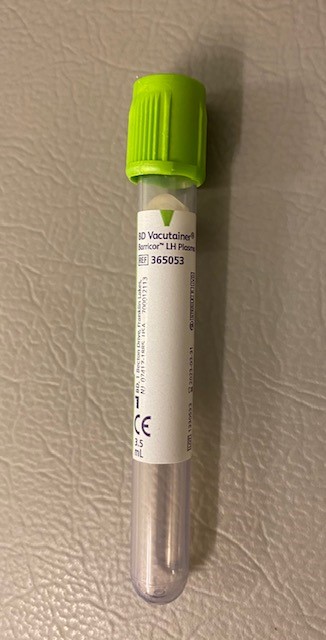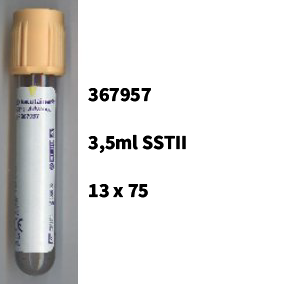| Referentiewaarden: |
| Leeftijd/Puberteit Meisje |
LH (U/l) |
FSH (U/l) |
Oestradiol (nmol/l) |
| Neonaat: |
|
|
|
| Bij geboorte (a terme) |
< 0,1 - 1,5 |
< 0,1 - 5 |
|
| 5 - 50 dgn postpartum (a terme) |
< 0,1 - 5 |
< 0,1 - 20 |
|
| Bij geboorte (prem, < 30 wk GA) |
< 0,1 - 5 |
1 - 15 |
|
| 5 - 50 dgn postpart (prem, 30 wk GA) |
< 0,1 - 50 |
1 - 120 |
|
| Kind/Meisje: |
|
|
|
| Puberteitsstadium I |
< 0,1 - 1 |
0,3 - 5 |
< 0,04 |
| Puberteitsstadium II |
< 0,1 - 5 |
0,6 - 7 |
< 0,04 - 0,3 |
| Puberteitsstadium III |
0,6 - 10 |
3 - 10 |
< 0,04 - 1,5 |
| Puberteitsstadium IV en V |
Cyclusafhankelijk |
|
| Cyclus/Vrouw |
LH (U/l) |
FSH (U/l) |
Oestradiol (nmol/l) |
Progesteron (nmol/l) |
| Cyclus: |
|
|
|
|
| Vroeg folliculair (dg -15 tot -6) |
0,4 - 9 |
2 - 11 |
0,05 - 0,4 |
0,3 - 3 |
| Laat folliculair (dg -5 tot -1) |
2 - 10 |
3 - 10 |
0,2 - 1,5 |
0,3 - 2 |
| LH piek (dg 0) |
20 - 75 |
5 - 20 |
0,5 - 1,5 |
1 - 5 |
| Vroeg luteaal (dg 1 tot 4) |
3 - 22 |
2 - 16 |
0,1 - 0,7 |
5 - 50 |
| Mid luteaal (dg 5 tot 9) |
1 - 11 |
1 - 8 |
0,2 - 0,8 |
30 -70 |
| Laat luteaal (dg 10 - 14) |
0,4 - 9 |
1 - 8 |
0,1 - 0,7 |
4 - 40 |
| Postmenopausaal |
15 - 60 |
20 - 150 |
< 0,04 - 0,1 |
< 0,3 - 3,0 |
| Leeftijd/Puberteit/Jongen/Man |
LH (U/l) |
FSH (U/l) |
Oestradiol (nmol/l) |
Testosteron (nmol/l) |
| Neonaat: |
|
|
|
|
| Bij geboorte (a terme) |
< 0,1 - 1,5 |
< 0,1 - 2 |
|
|
| 5 - 50 dgn postpartum (a terme) |
< 0,1 - 10 |
< 0,1 - 10 |
|
|
| Bij geboorte (prem, < 30 wk GA) |
0,4 - 14 |
< 0,1 - 3 |
|
|
| 5 - 50 dgn postpart (prem, 30 wk GA) |
0,1 - 8 |
< 0,1 - 2 |
|
|
| Kind/Jongen: |
|
|
|
|
| Puberteitsstadium I |
< 0,1 - 1 |
0,1 - 3 |
< 0,04 |
< 0,4 - 1 |
| Puberteitsstadium II |
< 0,1 - 3 |
0,1 - 5 |
< 0,04 |
< 0,4 - 13 |
| Puberteitsstadium III |
0,5 - 6 |
0,5 - 10 |
< 0,04 - 0,1 |
1 - 22 |
| Puberteitsstadium IV |
1 - 6 |
1 - 10 |
< 0,04 - 0,1 |
7 - 30 |
| Puberteitsstadium V |
1 - 8 |
1 - 10 |
< 0,04 - 0,2 |
10 - 35 |
| man |
1 - 10 |
1 - 10 |
< 0,04 - 0,2 |
10 - 35 |
|
| Bronvermelding: |
-
Elmlinger MW, Kuhnel W, Ranke MB: Reference ranges for serum concentrations of lutropin (LH), follitropin (FSH), estradiol (E2), prolactin, progesterone, sex hormone-binding globulin (SHBG), dehydroepiandrosterone sulfate (DHEAS), cortisol and ferritin in neonates, children and young adults. Clin Chem Lab Med 2002;40(11):1151-1160
-
Kaplan LA, Pesce AJ: The gonads. In Clinical Chemistry: Theory, Analysis, and Correlation. Third edition. Edited by SC Kazmierczak. St. Louis, MO, Mosby-Year Book, Inc, 1996, p 894
-
Dumesic DA: Hyperandrogenic anovulation: a new view of polycystic ovary syndrome. Postgrad Ob Gyn 1995;15:1-5
|

